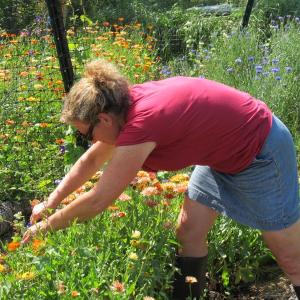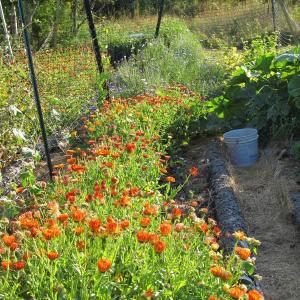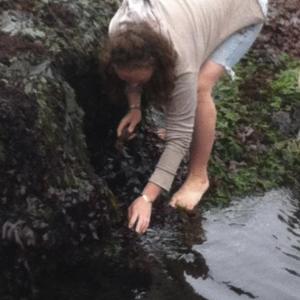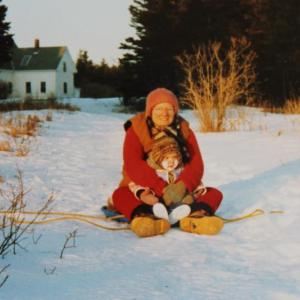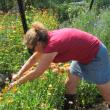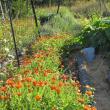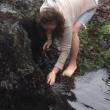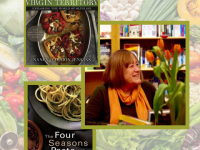The ‘Giving Island’
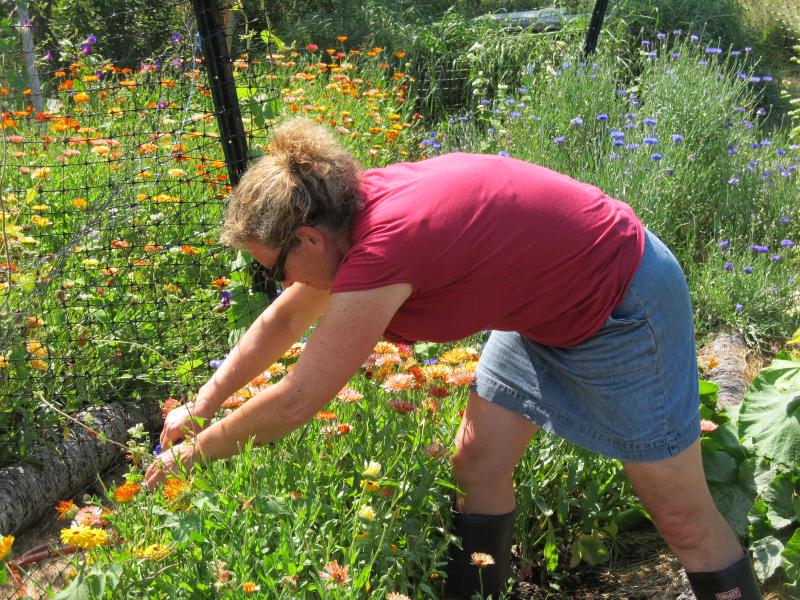 Claire Weinberg picks calendula blossoms from her garden on Gott Island, off Mount Desert, to turn it into a face cream for her company, Dulse & Rugosa. (Photo by Kay Stephens)
Claire Weinberg picks calendula blossoms from her garden on Gott Island, off Mount Desert, to turn it into a face cream for her company, Dulse & Rugosa. (Photo by Kay Stephens)
 Rows of calendula in the Dulse & Ruogsa growing gardens on Gott Island. (Photo by Kay Stephens)
Rows of calendula in the Dulse & Ruogsa growing gardens on Gott Island. (Photo by Kay Stephens)
 Carly harvesting seaweed. (Courtesy Claire Weinberg)
Carly harvesting seaweed. (Courtesy Claire Weinberg)
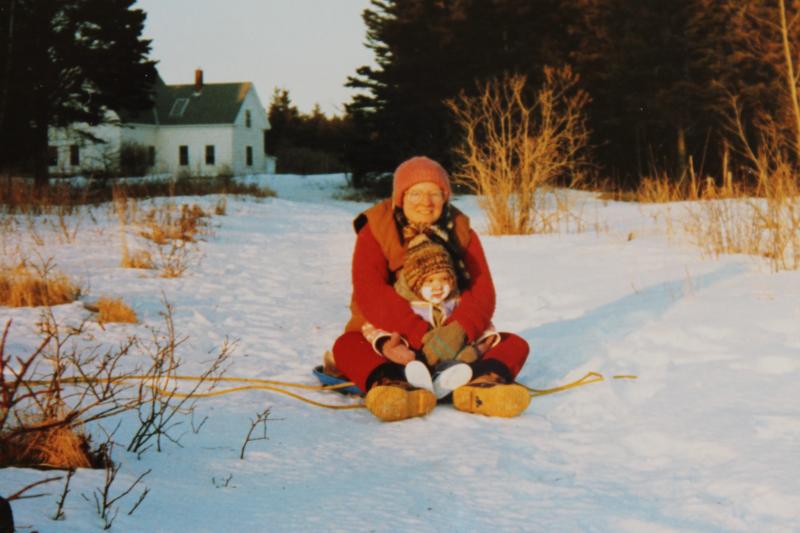 Claire and Carly in 1985 on Gott Island during the winter. (Courtesy Claire Weinberg)
Claire and Carly in 1985 on Gott Island during the winter. (Courtesy Claire Weinberg)
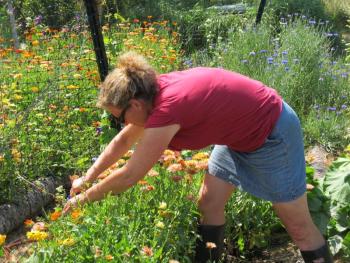 Claire Weinberg picks calendula blossoms from her garden on Gott Island, off Mount Desert, to turn it into a face cream for her company, Dulse & Rugosa. (Photo by Kay Stephens)
Claire Weinberg picks calendula blossoms from her garden on Gott Island, off Mount Desert, to turn it into a face cream for her company, Dulse & Rugosa. (Photo by Kay Stephens)
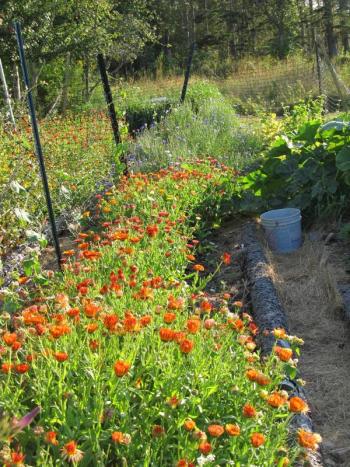 Rows of calendula in the Dulse & Ruogsa growing gardens on Gott Island. (Photo by Kay Stephens)
Rows of calendula in the Dulse & Ruogsa growing gardens on Gott Island. (Photo by Kay Stephens)
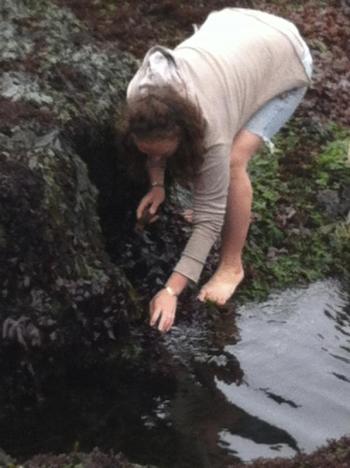 Carly harvesting seaweed. (Courtesy Claire Weinberg)
Carly harvesting seaweed. (Courtesy Claire Weinberg)
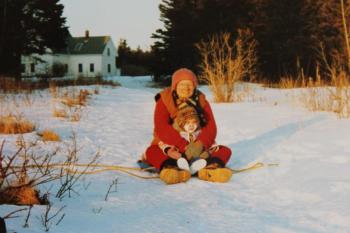 Claire and Carly in 1985 on Gott Island during the winter. (Courtesy Claire Weinberg)
Claire and Carly in 1985 on Gott Island during the winter. (Courtesy Claire Weinberg)
GOTT ISLAND — Remember the classic children’s book, The Giving Tree by Shel Silverstein? Well, two Maine women are making their living from the “Giving Island.”
Let me paint the picture, because it’s almost straight out of a novel. When the remote Gott Island, off the coast of Mount Desert, awakens in the spring, Claire and Carly Weinberg, the mother-daughter co-owners of the Maine natural skin care line, Dulse & Rugosa, will come back to it and open up their little houses. They will live off the grid, like everyone else, amid dozens of spread-out houses owned by generations of families.
When everything starts to bloom and grow, they will get up, have some coffee on Claire’s big, sunny wraparound porch. Then they will spend their days gathering baskets of St. John’s Wort and rose hips from the meadows, and balsam needles and bay leaves from the wooded trails. Claire will pluck the pink and red Rugosa rose petals from the island hedges as Carly wends her way along the wild shoreline, harvesting seaweeds such as dulse, sugar kelp, finger kelp, and nori. They will turn all off the island’s natural botanicals into skin care products such as body butters, sea salt scrubs, facial oils and bath teas. After years of experimenting with all of these pure ingredients in their own homemade products, Dulse & Rugosa was born.
At the end of the summer, I was invited to spend some time on Gott Island with Claire to observe how this all worked.
On a bright blue-sky day, I was taken out by private boat and met Claire at the landing. As we lugged my backpack and some bags about a half-mile up the grassy hill to her house, I could hear the loud drone of crickets. There are no cars, stores or ferry service, and only solar electricity on the island. There are no roads, either, just trodden footpaths. As we approached her property, the first thing I saw was this stick-built cozy, country house with a wrap-around porch. Next to it was an even more diminutive yellow guest house, where Carly stays when she’s on island. But she wasn’t here on this day, so that was to be my lodgings.
After settling in, Claire and I went for a walk around the island so she could show me their best harvesting spots. "We have somewhere between five and seven acres," said Claire as we walked through her fields.
As we walked, I got to know Claire, who is soft-spoken and laughs easily. She made me feel instantly right at home, as if we’d known each other for years.
Lest you think this is too dreamy to be real, or that island living is something ripped out of a soft focus Martha Stewart catalogue shoot, Claire revealed how she’d come to the island. This was her former husband’s family land, a place they’d built their home together for 30 years. In the early 1980s, the Weinbergs were the only ones hearty enough to live on the island year-round (Carly was only a day old when she came onto the island). They grew their own food, chopped wood for their wood stove and raised their own animals. It was this do-it-yourself unity that led the family to conceive of harvesting the botanicals that the island produced each year, and turn them into products they could sell.
"We've been wanting to do a business using the resources of this island for awhile, but it had to make sense for where we live. You can't do a market garden because we're just too far away," said Claire. It was not only a unique way to make a living, but also a way to share the beauty and power of the island with others. Dulse & Rugosa started with her husband and Carly's father in the picture. But rather abruptly, Claire's husband decided to go his separate way last year, and in the divorce, he granted the family land to Carly and gave over the business to both of them.
Claire and Carly have been dealing with their emotions over this adjustment in the family dynamic, in addition to trying to figure out how to continue Dulse & Rugosa on their own.
"We thought, what do we do?” Claire said, telling me she and Carly had quit their jobs when they started the business. The original plan was that Claire’s husband would work overseas for a few years to sustain the family while Claire and Carly launched the business. “We thought, ‘Do we quit? Do we keep going? How are we going to survive?’"
Dulse & Rugosa hadn’t been in operation even a year when Claire and Carly decided to pull together their strengths and keep going as a mother-daughter team. To make ends meet with their start-up costs, Carly took a temporary job in Rockland this summer (where they also bought a house for the production side of the business) while Claire worked on the island, harvesting. This is the first summer they've been able to sell their products and while they don't have a real picture of their business numbers yet, they're focusing on ramping up production and marketing through the fall and winter.
Around dinner time, Claire showed me one of the most blazing and beautiful spots on their property — the garden-grown botanicals they've set aside for Dulse & Rugosa, with rows of yellow, red and orange calendula and blue bachelor’s button. Hedges of Rugosa roses dotted the front of the house. Everything smelled fresh and sweet out there, mixed with tangy island air. Claire and Carly have been cultivating their island gardens for about 20 years. The back and sides of the main house are reserved for an expansive vegetable garden and a teeny greenhouse that serve as their food source while they live there. To fertilize the garden beds, they’ve pulled earth and loam from the forest and added dried seaweed to it to make their own compost.
After Claire stuffed her hands into a mound of dirt and plucked out some dusky potatoes out, she instructed me to go over to the rain barrel and scoop out some rainwater to pre-wash the potaoes while she went to pick salad ingredients. The biggest insight I got as I squat down with a colander and used a scoop of rainwater and my hands to scrub the dirt from the small red, blue and white potatoes is that nothing can go to waste here. Even though she has a well and a sink in her house, it’s a better use of resources to use the barrel of rainwater for the first wash. This isn’t some back-to-the lander Helen Nearing effort, this is what you do to make it work on an island.
Over an excellent dinner with those grilled potatoes sprinkled with dried dulse, a huge, fresh-picked salad and plump chicken sausages she’d fired up on an outdoor stone grill, we got down to what her day-to-day life was like out there.
Growing the gardens takes a lot of initial work and outlay. But picking and harvesting is only the first phase. With calendula, for example, you have to separate the petals from the center. "That's something we'll do on some rainy or snowy night. We'll get the wine out and just sit there and work on it,” said Claire. They have to work in batches, making products when the ingredients are ready with the seasons.
"This summer has been rainy and foggy, which hasn't been good for rose petals, but it's been fabulous for calendula," said Claire. She recalled frustrating soggy days when she would have to pluck wet Rugosa petals and painstakingly separate them so they could dry.
As their ingredients are all natural, there is a finite amount one can gather, pick and harvest in one season. In early spring, the seaweeds are ready to be harvested. “Carly is the seaweed picker,” said Claire. “She’s the one with the seaweed license and she goes to the far end of the island at low tide. She loves the ocean and she's really the science side of our business.” Claire shows me a bag of twisty purple dulse that had already been dried.
“I like this because it looks so pretty and we use it in our rose petal cream. Seaweeds are rich in vitamins and minerals, gentle for your skin and full of natural goodness,” she said.
Next, all of their botanicals have to be air-dried, which can seem like a tedious process, then they have to be bagged and transported to Rockland for the next steps.
Not everyone can work well with a family member, but Claire and Carly are pretty tight and have been since Carly was in high school. In the Rockland house, they live together as housemates and work very well together. "We get along really well and have this policy ever since the divorce: don't judge," Claire said with a laugh. "And we actually split up our time well with one of us on the island doing the gathering and the other in Rockland doing the production and selling, so it’s not like we’re stuck at the hip all the time."
Twenty-four hours went by fast on Gott Island, and in that time I got a glimpse of its beauty and timelessness. To visitors, that seems to be the prominent takeaway, but it can be a different reality for those who live there, or on any island. Tended responsibly and sustainably, Gott Island will always be the “Giving Island,” but one has to work hard for it. Part of that work is endurance—days of solitude, inhospitable weather, doing without creature comforts.
And I think, after having met Claire (and days later Carly), they embody the perennial strength of dulse and the Rugosa rose, which come back every year. In the spring, so will Claire and Carly.
Related link:
Kay Stephens can be reached at news@penbaypilot.com
Event Date
Address
Gott Island, ME
United States

